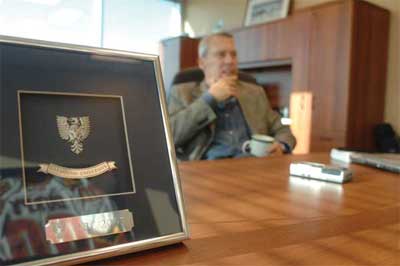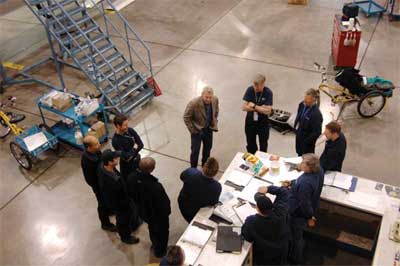 |
| Sean Durfy is a proud Dal grad. He hosts functions for Calgary high-school students contemplating going to HÂț». (Danny Abriel Photo) |
The guy driving the baggage cart is whistling.
The customer service representative click clacks on high heels around the counter to lift a heavy bag on the carousel for an elderly man.
The flight attendant cracks jokes on the trip across the country: âLet me remind you this is a nonsmoking flight, as are all WestJet flights,â she says as the airplane lifts off. âIf youâre caught smoking, youâll be asked to leave the aircraft immediately.â
And, at WestJetâs head office in Calgary, the front-desk receptionist sings out a sunny âgood morning!â When comedian Rick Mercer investigated the âhysterically happy WestJettersâ phenomenon on his TV show, he approached a smiling ticket agent for the airline with some frustration: âHas a memo gone out?â

âYou either believe in the place or you donât; youâll know pretty much within the first six months of working here,â says Mr. Durfy (BCom â89), president and CEO of WestJet.âIt is really is about aligning the interests of our people with the interests of the company. Itâs all about our culture.â
WestJetâs mission, vision and value statementsâthe same ones mounted and displayed in the lobbyâhang from the lanyard around his neck. The mission is âto enrich the lives of everyone in WestJetâs world by providing safe, friendly and affordable air travel.â The vision is to be one of the five most successful international airlines in the world by 2016.
Top five in the worldâisnât that overreaching? Just on the basis of its bottom line, WestJet has already achieved its vision. With a 16 per cent operating margin, WestJet ranks as the fourth most profitable airline in the world, behind Irelandâs Ryanair, Panamaâs Copa and Malaysiaâs AirAsia. Itâs an amazing accomplishment, given that the upstart company only took to the skies 12 years ago with three planes flying to five destinations. Now having a market value at more than $2 billion, the low-cost carrier has 74 Boeing next-generation 737s, employs 7,000 people and has played host to 11.9 million âguests,â in WestJet lingo.
The company recently underwent an expansion with the launch of WestJet Vacations; it now flies to 27 destinations in Canada, 12 in the United States and seven hotspots in the Caribbean, including Mazatlan, Mexico; Montego Bay, Jamaica; and Nassau in the Bahamas.
WestJetâs carefully managed growth is all the more impressive considering the turbulence thatâs plagued the airline business in recent years, including the security and safety concerns raised in the wake of 9/11.Indeed,WestJet has survived and thrived when many other low-cost airlinesâGreyhound Air, Roots Air, Royal, CanJet, Jetsgo and Canada 3000âwere grounded when profits never took off. Even Air Canada was affected, filing for bankruptcy protection in 2003 after suffering a string of heavy losses, emerging as a leaner, more efficient airline. But now as the skies clear over Canada, the turbulence continues south of the border, with a downturn in the U.S. economy cutting into travel demand. Delta,one of the biggest U.S. airlines, has just cut back on its workforce. American Airlines recently had to cancel more than 3,000 flights because of maintenance issues.
Airline Weekly, the trade paper for the airline industry, documented WestJetâs success in March under the headline, âBestJet: What makes WestJet one of the worldâs most successful airlines?â With the salutation âHello WestJetters,â Mr. Durfy forwarded the story to every employee. Heâs tickled about âBestJetâ and likes to use it himself.
âFor me, itâs never been about nice planes and comfortable leather seats,â says Mr. Durfy, 42, a Calgarian by way of Corner Brook, Nfld.âI just get juiced by the people weâve got here and what weâre offering.â
Heâs actually still settling into the place and the position â the corner office with the sign in the hallway which simply says âSean and Hugh.â (Hugh is Hugh Dunleavy, executive vice-president for commercial distribution.) The windows, offering a scenic view of the parking lot below, are lined with photographs: five-year-old daughter Kennedy at the Calgary Stampede; Kennedy at a Calgary Flames game; 15-month-old son Reilly in wife Tracyâs arms; Mr. Durfy and Mr. Mercer taken during the fellow Newfoundlanderâs WestJet âinvestigationâ; and with friends at a Great Big Sea concert in Calgary. He has another photo of himself that he keeps close by but tucked away in a desk drawerâheâs 10 years younger and 50 pounds heavier.
âI was 33 years old and I looked like I was 50. I was told at the Foothills Medical Centre that I was bound for a heart attack unless I made some dramatic changes. So I try very hard to keep a balance in my life,â he says. He runs most mornings before arriving at work around 9 a.m. and returns home in time to give the kids their baths and read their bedtime stories. During this interview, he sips vegetable juice from a rinsed roll-up-the rim cup.
Mr. Durfy arrived at WestJet four years ago on the invitation of the companyâs energetic founder Clive Beddoe, a real-estate developer and pilot who led the company through a period of explosive growth. At the time, Mr. Durfy had spent 10 years in the Alberta energy industry, where he was president and chief operating officer of ENMAX Corporation, the energy utility for the City of Calgary. He and Tracy were looking for a change; they had drawn up a business plan and were going to buy and operate a hotel in the Caribbean when a friend called with a suggestion, âWhy donât you meet this guy Clive Beddoe?â
A 20-minute meeting turned into two hours and by the end of it, Mr. Durfy wanted to join WestJetâs executive team. He did in December 2004, as executive vice-president for sales, marketing and airports. He became WestJet president in September 2006 and added chief executive officer to his title last September, as Mr. Beddoe moved to become chairman of the companyâs board of directors.
He winces as he admits it, but he didnât really get WestJetâs down-home corporate culture at first. Within months of his arrival, he was ready to go ahead with a multi-million dollar, national advertising campaign dubbed âWest Jetiquette.â Described as witty and tongue-in-cheek, the campaign included three TV spots outlining the dos and donâts of flying on WestJet. In one ad passengers are told: âDo love WestJetâs leather seats, but donât get romantic with them.â
âKind of at the last moment, we thought, âLetâs show our folks,â and we had a big meeting in the hangar,â recalls Mr. Durfy. âThe reaction was very strongâthey thought I was making fun (of them). I thought I was going to be killed by the angry mob.â
He pulled the campaign the day before it was due to air, and rolled up his sleeves to lead development on a new one.
âIt was a hard lesson. They were telling me,âYou donât get us yet.ââ
Within six weeks, the marketing team shaped the highly successful âBecause Owners Careâ campaign, with the now-familiar line, âWhy do WestJetters care so much? Because weâre also WestJet owners.â Folksy, fun, even a little corny, the campaign reflects the pride employees have in the company; more than 84 per cent of them are WestJet shareholders. They can dedicate up to 20 per cent of their salary in share purchases, an amount matched by the company. Theyâre also encouraged to offer input on how the airline runs. One of the ads features a flight attendant rocking a crying baby in the aisle; when she returns the baby to arms of the exhausted parents, everyone in the cabin is snoozing, too. Another adâthe one mercilessly parodied on This Hour Has 22 Minutes and the Rick Mercer Reportâfeatures the efficient flight attendant who not only returns a passengerâs briefcase left behind on the plane, she pumps up his power-point.
 |
| Sean Durfy (in brown jacket) talks with maintenance workers in the WestJet hangar. (Danny Abriel Photo) |
The ideas behind Because Owners Care have led WestJet to top the annual list of Canadaâs 10 most admired corporate cultures three years in a row. Other companies to receive the designation, from Waterstone Human Capital, include Four Seasons Hotels, Boston Pizza International and the Royal Bank of Canada. When Mr. Durfy heard about the latest honour, he was in a customer-service-repâs uniform at the Calgary airport pitching in during the holiday rush.
WestJetâs caring attitude is not for show, like the best set of china that gets dusted off for company. Itâs something the airlineâs employees believe in passionately. And, since Mr. Durfy âlearned his lesson,â they believe in him, too.
In the hangar, scene of his comeuppance, maintenance workers checking over a 737 are heckling their boss as he gets his photograph taken for the magazine.
âThis place is a lot different from other companies. I mean, look at the guy,â says Duane âPottsâ Potekal with a glance in Mr. Durfyâs directionâheâs standing on the wing of the plane. âYou never see the bigwigs unless theyâre coming to say âWeâre shutting you down.â He knows our names. He comes and talks to us.â
WestJetter Vern Guenther admits to some apprehension when he heard the respected Mr. Beddoe was stepping down.
âSean had to learn the WestJet culture, but (Clive Beddoe) taught him well,â he says. âThat campaign he showed us, oh it was funny and all that, it just wasnât us. But he nailed it on the head with the Owners Care campaign.â
âIf youâre going to work at an airline, you want to work at WestJet,â adds Lorraine Stewart, from Cape Breton, while cleaning the cockpit. âHe sets the pace. From us little old cleaners to the pilots, we all really like being WestJetters.â
'A shining example'As the kid from Corner Brook, Sean Durfy says coming to HÂț» was the formative experience of his life. âIt defined me as a person, I would say,â says Mr. Durfy, president and CEO of WestJet. Heâs one of HÂț»âs biggest boosters in Calgary, dressing his children in Dal sweatshirtsand hosting functions for Alberta students who are deciding where to go after high school. But not alwaysâhe got a failing grade on his first-year marketing class, a mark that only made him more determined. (âI was made to feel like a meathead,â he rails. âI thought, screw that, Iâll make marketing my major.â) He graduated in 1989 with a double major in marketing and finance and was the valedictorian of his class. Frederick G. Crane, now at Northeastern University in Boston, remembers being impressed with Mr. Durfyâs drive and entrepreneurial spirit. He has stayed in touch with his former student and features his leadership role at WestJet in his textbook, Marketing (McGraw-Hill Publishing). âIâve taught him everything he knows,â he jokes. âBut seriously,â he continues. âI believe he is a shining example of the type of education students receive at HÂț» ⊠Clearly, Seanâs energy and innovativeness have helped WestJet become a major brand in its category. A combination of his innate abilities and the education he received are the platform of his success.â |
